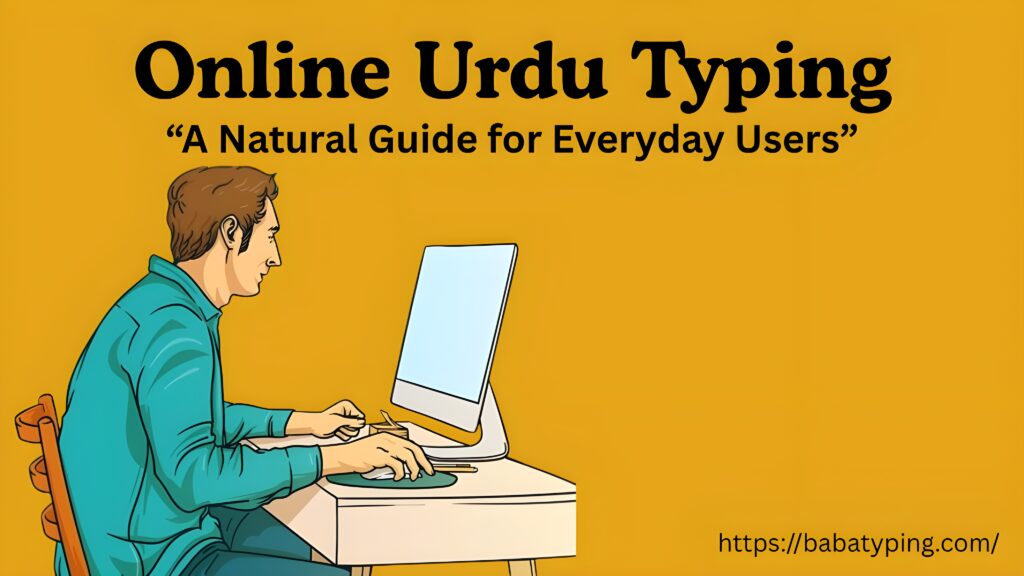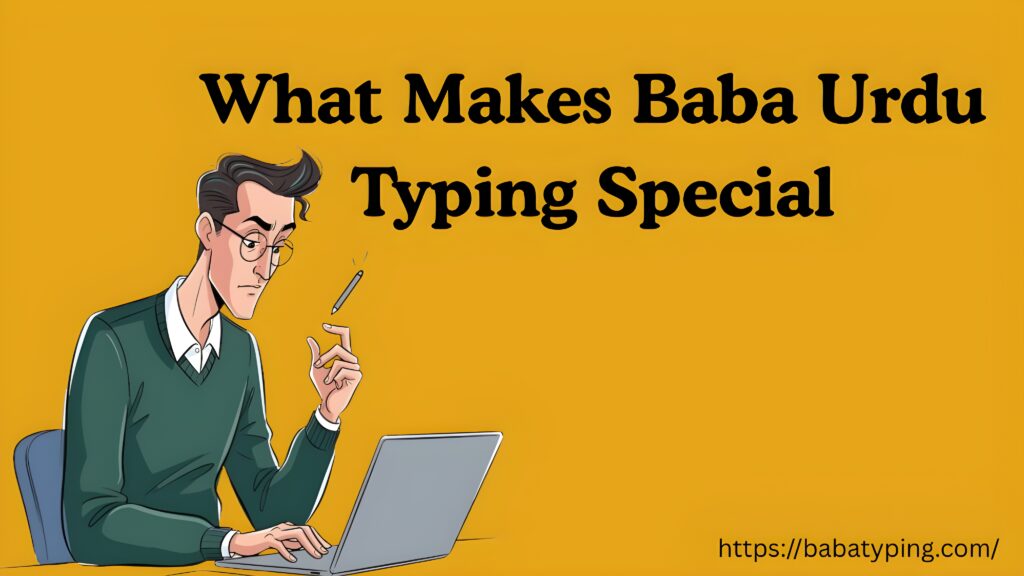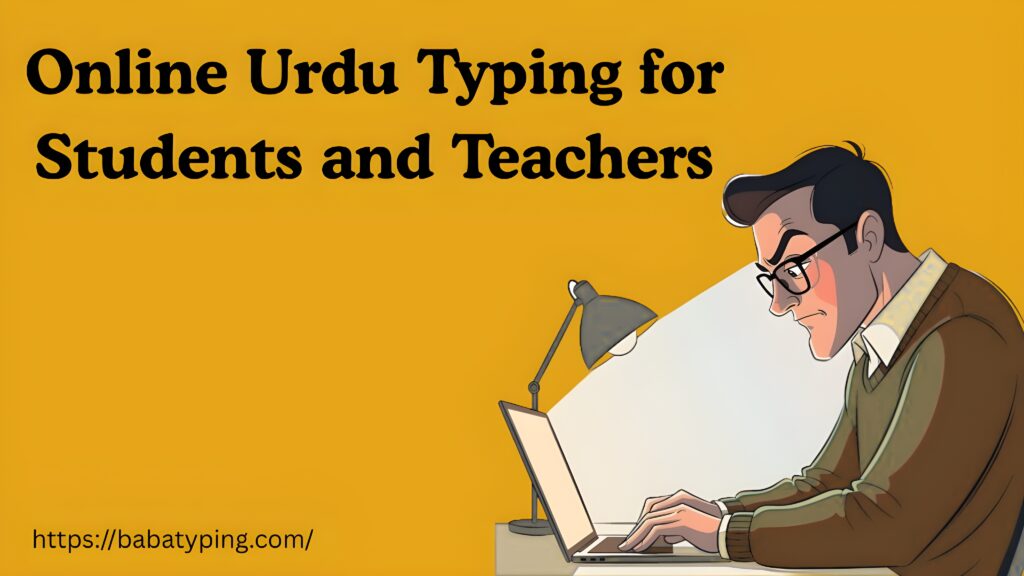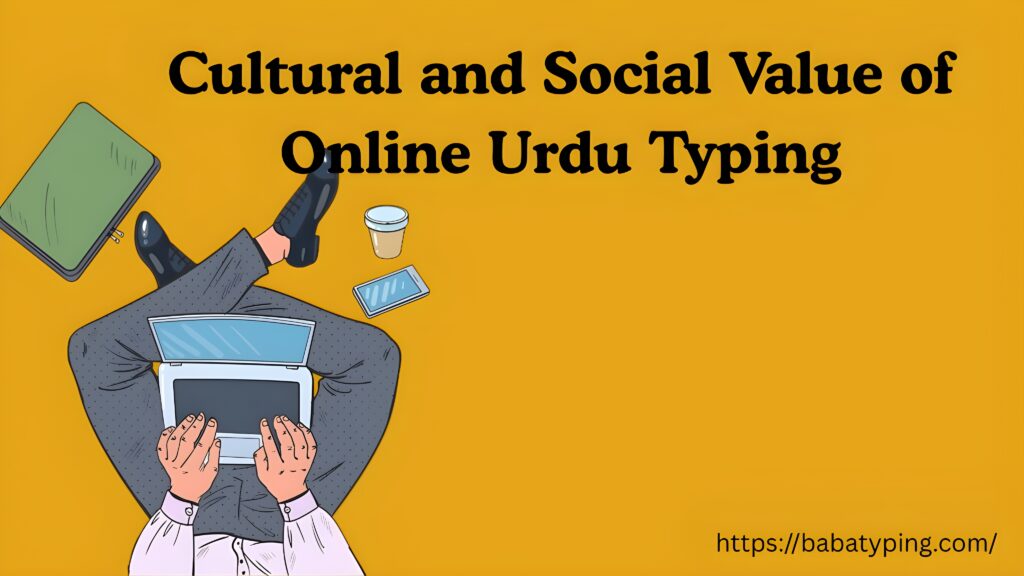
There was a period when typing in Urdu seemed like a duty. Ten years ago, if you were in college or university, you likely recall sitting in front of a desktop computer with InPage installed, striving to find your position on the keyboard. Half of the students gave up and merely shared in Roman Urdu ap kaise ho, kitna time hai, assuming that was sufficient. It was more difficult to correctly type Urdu than it was for them not to love it.
Things have evolved. Today, opening a browser tab will let you type in Urdu. Thanks to sites like Baba Urdu Typing, you neither have to download anything nor memorize a unique keyboard layout. Simply type in Roman letters, and the system will create a lovely Urdu script of your words. The first time you attempt, it feels like magic.
In this blog, let’s take a closer look at how online Urdu typing works, why Baba Typing has become so popular, and how it’s helping students, teachers, freelancers, and even casual users bring Urdu into the digital world.
History and Evolution of Urdu Typing
Typing in Urdu has come a long way over the years. In the early days, people relied on software like InPage to write in Urdu. While it was a useful tool at the time, it required complicated installations and memorizing a difficult keyboard layout. Many students and professionals avoided it because it felt more like a technical challenge than a writing tool. As a result, Roman Urdu typing Urdu words with English letters became the shortcut for everyday digital communication.
With time, improvements like phonetic keyboards and third party typing tools appeared, but most of them still required downloads and extra setup. This limited their accessibility for casual users. The real change began when online platforms made Urdu typing possible directly in the browser. Baba Typing played a central role in this shift. Combining an online Urdu keyboard with Roman Urdu conversion made typing effortless. Today, online Urdu typing is no longer restricted to experts; anyone can do it in seconds, from students writing essays to professionals preparing reports.
Why Online Urdu Typing Matters Today
Urdu is not just another language. It carries poetry, history, and the everyday conversations of millions. But the problem has always been technical: how to use it online without breaking letters or struggling with fonts. When most platforms were built around English, Urdu speakers were left behind.
Imagine a journalist trying to publish an Urdu article on a website, but stuck because the editor didn’t support Urdu fonts. Or a student writing an essay who spent hours fixing alignment issues. These hurdles discouraged people.
But with online tools, everything has changed. Now you type anywhere, anytime. Whether you’re on a laptop in an office, a student in a hostel, or simply on your mobile while traveling, you can get clean, readable Urdu instantly. Baba Urdu Typing has been a major part of this change.

What Makes Baba Urdu Typing Special
The reason many users trust Baba Typing is not because it’s the only tool available but because it works without fuss. Open the website, type, and your words are right there. No downloads, no tricky setup, no wasted time.
It offers:
- An Urdu keyboard online: You see all the letters laid out clearly, so even if you’re new, you can click directly on the characters.
- Roman Urdu conversion: Write “dost” or “zindagi,” and watch them appear as دوست and زندگی.
- Readable fonts: Including the much loved Jameel Noori Nastaleeq, which makes writing look polished and professional.
- Copy and paste: Once your typing is done, you copy it with one click and use it anywhere in MS Word, social media, or emails.
- Completely free: No sign up walls, no hidden fees, just open access.
The simplicity is what keeps people coming back.
Step by Step Guide to Using Baba Typing
One of the reasons Baba Typing has become so popular is its simplicity. It doesn’t ask you to download software or learn a complicated system. Anyone can start typing in Urdu online within seconds by following these steps:
- Open the Baba Typing website in your browser.
- Start typing in Roman Urdu, for example, type “dost” and it will appear as دوست.
- If you prefer, use the on screen Baba Typing Urdu keyboard to click and type each letter.
- Choose from different Urdu fonts, including the elegant Jameel Noori Nastaleeq, to make your writing look professional.
- Once your text is ready, copy it with one click and paste it anywhere in Word documents, social media posts, or emails.
- Whether you are on a laptop, desktop, or mobile phone, the tool works smoothly without slowing down.
This simple process is why people prefer online Urdu typing with Baba Typing over traditional methods. It saves time, effort and makes the experience enjoyable.
Everyday Uses of Baba Urdu Typing
If you think about it, Urdu typing touches more lives than we realize. Here are some examples where people actually use Baba Typing:
- Students preparing Urdu essays, literature assignments, or typing their poetry.
- Teachers are creating question papers, handouts, and notes in Urdu.
- Freelancers working on typing projects, Urdu subtitles, or translation jobs.
- Journalists and bloggers are publishing Urdu content online.
- Everyday users who just want to send a heartfelt status or message in Urdu instead of Roman text.
The beauty of Baba Typing is that it doesn’t matter if you’re a beginner or an expert; it adapts to both.
Expanded Practical Use Cases of Online Urdu Typing
Online Urdu typing is more than just a convenience; it has real world applications across education, work, and communication.
- Students: Use it to prepare assignments, essays, and creative writing in neat Urdu fonts.
- Teachers: Save hours by creating question papers, notes, and study material directly in Urdu.
- Freelancers: From Urdu book typing to translation and copy paste tasks, this tool helps complete projects quickly and professionally.
- Media professionals: Journalists, writers, and bloggers rely on online Urdu typing to publish articles, news reports, and blog posts without formatting issues.
- Job seekers: Government exams and typing tests often include Urdu typing sections, and practicing with Baba Typing helps improve speed and accuracy.
- Everyday communication: Social media users, poets, and even casual chatters use it to share messages, statuses, and poetry in authentic Urdu script.
These practical uses show how online Urdu typing has become a part of daily digital life, making the language more accessible than ever before.

Online Urdu Typing for Students and Teachers
Let’s start with education. Walk into any Pakistani or Indian classroom where Urdu is taught, and you’ll find students struggling with handwritten assignments. Teachers, on the other hand, are stuck with preparing exam material on Word processors that don’t properly handle Urdu fonts.
With Baba Typing, both groups find relief. Students can type essays in neat Nastaleeq font, which is much easier to submit and read. Teachers can prepare notes and papers without worrying about alignment. It saves time and effort and brings professionalism into academic work.
Urdu Typing for Freelance Work
The freelance market has exploded in recent years. Platforms like Fiverr and Upwork are full of small tasks that require Urdu book typing, data entry in Urdu, and even English to Urdu typing for reports.
For freelancers, Baba Typing is more than a tool; it’s an opportunity. Instead of wasting time setting up software, they can get straight to work. The Urdu touch typing practice feature also helps them build speed, a critical skill when deadlines are tight.
Professional Uses: Media and Communication
Journalists often work against deadlines. A tool like Baba Typing allows them to draft articles quickly, whether they’re writing political commentary, cultural reports, or social issues coverage. Similarly, bloggers who want to connect with an Urdu speaking audience rely on such platforms for neat formatting.
Even in offices, official letters and circulars often need to be prepared in Urdu. Instead of calling IT staff to install fonts or troubleshoot, employees can simply use Baba Typing and get their work done.
Why People Prefer Typing Online Instead of Software
The older generation of Urdu typists might still remember struggling with InPage, where every mistake meant wasted time. If fonts weren’t installed, the text wouldn’t even display on another computer.
Compare that with online typing:
- It works instantly in any browser.
- There’s no installation or technical setup.
- The fonts are already built in.
- You can use it on a computer or mobile with equal ease.
That’s why more people are shifting toward online tools. They don’t just save time; they reduce frustration.
Practice and Speed Improvement
Typing speed is vital whether you are preparing for a government typing exam or working as a freelancer. Baba Typing provides its users with online Urdu typing tests, on which the users can check their WPM and accuracy and gradually build muscle memory over time. For example, taking a 20 word per minute student, within a couple of practice weeks, they could comfortably achieve up to 40 or more words per minute. That progressive change is enough to turn neophytes into confident typists.
Urdu Typing on Mobile Phones
I mean, we hardly post anything apart from our wall on social media, and most of it is a passing message or something that quicks goes on the mobile. Baba Typing works perfectly on mobiles, so I don’t have to depend idly on such crummy applications or keyboards whose letters do not appear when needed.
Whether it is for your Facebook status, Urdu tweeting, or just a WhatsApp message, it is all possible in seconds, thanks to the mobile version.
Online Urdu Typing and Cultural Preservation
This is bigger than just convenience. Every language that adapts to the internet has a better chance of surviving in the modern world. English and Hindi already dominate digital spaces. For Urdu to thrive, it needs tools that make it accessible.
Baba Typing is playing its part by ensuring anyone, from a school kid to a professional, can type in Urdu without difficulty. This not only keeps the language alive but also ensures it stays relevant in the digital era.
The Future of Urdu Typing
Looking ahead, Urdu typing online will only get more advanced. Imagine:
- Built in grammar and spell check for Urdu.
- Smarter predictive text to guess your words.
- Voice to text in Urdu for hands free typing.
- Direct publishing options to social media and blogs.
These changes are not far away. But for now, Baba Typing remains one of the most reliable ways to type Urdu online.

Cultural and Social Value of Online Urdu Typing
Not just any kind of tool, online Urdu typing has a cultural significance of its own. Urdu, in its very essence, embodies history, literature, and identity. Unfortunately, being almost impossible to type in any format, the language slowly began fading from the digital landscape. The advent of platforms for typing Urdu, like Baba Typing, has reversed this trend. They have made Urdu typing free and easy, thus providing wider channels for Urdu use across the Internet. Students now write in their native scripts, professionals prepare documents, and laypeople put out poetry and thoughts on the Web. Thus, in the digital age, the language stands to gain and prosper instead of being threatened by Roman scripts or other languages.
So Baba Typing gives birth to a new scheme of battle: a technical one and another in defense of the beauty of Urdu so that it might live for generations to come as a vibrant and agile communication system in the modern world.
Conclusion
Urdu has always made a special place for its people, but typing in Urdu has always been a hurdle. Baba Urdu Typing has taken away all of that. Onscreen keyboard, Roman conversion, or the clean Nastaleeq font, all of it has been so designed to make it easier for typing.
Well, this is how online Urdu typing is no longer a pain in the neck for students, professionals, freelancers, or casual users either. It’s quick, simple, and easy to use for all. More importantly, it makes sure that Urdu flourishes in the digital world, which is visible in the starvation of other languages for world attention.
The next time you ever need to put something in Urdu, whether it is an academic essay, a client project, or a social media post, just remember that Baba Typing has already done half of the work for you. Just pen your words down.
Frequently Asked Questions (FAQs)
What is Baba Urdu Typing and how does it work?
Baba Urdu Typing is a free online tool that lets you type in Urdu directly from your browser. You can either use the on screen Urdu keyboard or type in Roman Urdu (like “dost” or “zindagi”), and it will automatically convert it into Urdu script.
Do I need to install any software to use Baba Urdu Typing?
No, that’s the best part. You don’t have to download or install anything. It works instantly in your browser, whether you’re using a computer or a mobile phone.
Can beginners who don’t know Urdu keyboard layouts use it?
Yes. Even if you don’t know the Urdu keyboard, you can still type using Roman Urdu. For example, typing “khushi” will give you خوشی. Beginners often start with Roman Urdu and later get comfortable with the full keyboard.
Is Baba Urdu Typing useful for students and professionals?
Absolutely. Students use it to prepare essays and assignments, teachers create notes and papers, freelancers complete Urdu typing projects, and professionals draft documents. It saves time and ensures neat, readable text.
Can I practice and improve my Urdu typing speed here?
Yes. The platform includes typing practice and speed test options. With regular use, you can develop accuracy and speed, which is especially helpful for individuals preparing for typing exams or freelance work.
Does it support mobile typing as well?
Yes, Baba Urdu Typing works smoothly on smartphones. You can type Urdu on the go for social media posts, messages, or even longer documents without any issues.
